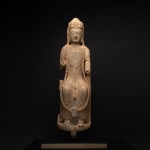Northern Wei Stone Sculpture of Guanyin, 386 CE - 557 CE
Gilt Stone
height 78.7 cm
height 31 in
height 31 in
PF.6163
Further images
-
(View a larger image of thumbnail 1
)

-
(View a larger image of thumbnail 2
)

-
(View a larger image of thumbnail 3
)

-
(View a larger image of thumbnail 4
)

-
(View a larger image of thumbnail 5
)

-
(View a larger image of thumbnail 6
)

-
(View a larger image of thumbnail 7
)

-
(View a larger image of thumbnail 8
)

-
(View a larger image of thumbnail 9
)

-
(View a larger image of thumbnail 10
)

-
(View a larger image of thumbnail 11
)

-
(View a larger image of thumbnail 12
)

This is an exceptional stone sculpture of Guanyin (Avalokitesvara in Chinese) from the Northern Wei Dynasty. Wearing an elaborate crown decorated with flowery patterns, the deity gazes downwards peacefully with...
This is an exceptional stone sculpture of Guanyin (Avalokitesvara in Chinese) from the Northern Wei Dynasty. Wearing an elaborate crown decorated with flowery patterns, the deity gazes downwards peacefully with mercy and kindness. Nicely executed decorative keyura hangs in front of his chest, heightening the elegance of his gown. His hands, although missing, must have formed the traditional Abhaya Mudra, which indicates that the faithful should have no fear but should put their trust in him.
Guanyin, meaning "One Who Hears the Cries of the World," the Bodhisattva of Mercy and Compassion, is the most popular and widespread of any deity in Chinese Buddhism. In the Buddhist religion, Bodhisattvas are souls who have attained enlightenment and no longer need to reincarnate, but forsake nirvana and choose to come back in order to alleviate the suffering of others. It is said that when Guanyin was ascending into the spirit realm he heard the cries of suffering humans and chose to re-enter physical existence. Thus, Guanyin makes helping others reach enlightenment his eternal mission. Originally depicted as a male in early Chinese Buddhist forms, the Guanyin eventually became associated with a local Chinese Mother Goddess, "bringer of children," and also because the gentleness and compassion of the deity suggest feminine qualities. Guanyin was often worshipped by local women who gave offerings to the goddess in exchange for his protection and guidance in domestic affairs.
It is a very rare early depiction of Guanyin seated on a drum stool. The extensive shimmering spots of crystallisation of the stone echoes with visible hints of gilding, reflecting a playful interaction of lights. The feeling of serenity that emanates from this religious figure is sure to touch those who share his presence.
Guanyin, meaning "One Who Hears the Cries of the World," the Bodhisattva of Mercy and Compassion, is the most popular and widespread of any deity in Chinese Buddhism. In the Buddhist religion, Bodhisattvas are souls who have attained enlightenment and no longer need to reincarnate, but forsake nirvana and choose to come back in order to alleviate the suffering of others. It is said that when Guanyin was ascending into the spirit realm he heard the cries of suffering humans and chose to re-enter physical existence. Thus, Guanyin makes helping others reach enlightenment his eternal mission. Originally depicted as a male in early Chinese Buddhist forms, the Guanyin eventually became associated with a local Chinese Mother Goddess, "bringer of children," and also because the gentleness and compassion of the deity suggest feminine qualities. Guanyin was often worshipped by local women who gave offerings to the goddess in exchange for his protection and guidance in domestic affairs.
It is a very rare early depiction of Guanyin seated on a drum stool. The extensive shimmering spots of crystallisation of the stone echoes with visible hints of gilding, reflecting a playful interaction of lights. The feeling of serenity that emanates from this religious figure is sure to touch those who share his presence.











